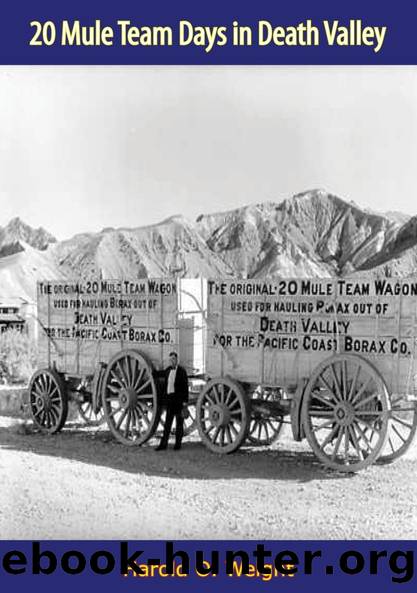20 Mule Team Days in Death Valley by Harold O. Weight

Author:Harold O. Weight [Weight, Harold O.]
Language: eng
Format: epub
Tags: Biography & Autobiography, Criminals & Outlaws, Rich & Famous, Social Science, Ethnic Studies, Native American Studies, History, United States, 19th Century
ISBN: 9781789120240
Google: nDxODwAAQBAJ
Publisher: Pickle Partners Publishing
Published: 2018-02-27T02:39:38+00:00
5âTHE LONE LINE SKINNERS
No more vivid and romantic figure has come down to us, through the legends that set forth the opening of the desert and the desert mines, than the long line muleskinner of Death Valley.
âTo see him soar up over the front wheel to his perch,â wrote John Spears, âtilt his hat back on a rear corner of his head, gather in the slack of a jerk line, loosen the ponderous brake, and waken the dormant energies of the team with âGit up,ââyou; git up!â is the experience of a touristâs lifetime. When the teamster pulls up beside the dump with the mules in a line so straight a stretched string would touch the ear of every mule on either side of the chain, as has often been done, one wanted to be introduced and shake hands.â
All the old Death Valley teamsters are gone now. And not one of them who handled the teams during the epic Death Valley-Mojave years of 1884-1888 seems to have left his story behind. Even the names of the muleskinners of those halcyon days of the twenty mule teams are unknown or uncertain.
John R. Spears, a star roving reporter on Danaâs New York Sun, who came to the deserts late in 1891 to do a series of sketches about desert borax, recorded the only observant first hand picture of their life. He visited the operating mines at Borate and in Nevada and the recently closed ones in the Death Valley country, traveling hundreds of miles along the old borax roads by buckboard. He talked with borax kings and desert outcasts, with miners, caretakersâand teamsters.
âIn freighting over the desert with a twenty animal team,â Spears wrote, âevery driver has an assistant called a swamper. On the down grade, he climbs to a perch on the rear wagon and puts on the brake; on the upgrade he reasons with and throws rocks at the indolent and obstreperous mules. As mealtime approaches, he kicks dead branches from a grease-bush along the route and pulls up sage-brush roots for fuel. When the outfit stops, he cooks the food while the driver feeds the animals, and when the meal is over, washes the dishes which, with the food, are carried in a convenient box in the wagon.
âThe mules get their grain from boxes which are arranged to be secured to the wagon tongue and between the wheels, when feeding. They eat their hay from the ground. Beyond feeding and watering they get no careâthey curry themselves by rolling on the ground with cyclonic vigor. The cloud of dust raised is suggestive of a Death Valley sandstorm.
âDrivers receive from $100 to $120 a month, swampers about $75. They furnish their own food and bedding. The bill of fare at a desert freight camp includes bacon, bread and beans for foundation, with every variety of canned goods known for the upper strata. They carry Dutch ovens for baking, pans for frying, tin kettles for stewing. A cobbler made of canned peaches serves for both pie and cake.
Download
This site does not store any files on its server. We only index and link to content provided by other sites. Please contact the content providers to delete copyright contents if any and email us, we'll remove relevant links or contents immediately.
The Lonely City by Olivia Laing(4772)
Animal Frequency by Melissa Alvarez(4431)
All Creatures Great and Small by James Herriot(4277)
Walking by Henry David Thoreau(3926)
Exit West by Mohsin Hamid(3797)
Origin Story: A Big History of Everything by David Christian(3666)
COSMOS by Carl Sagan(3593)
How to Read Water: Clues and Patterns from Puddles to the Sea (Natural Navigation) by Tristan Gooley(3434)
Hedgerow by John Wright(3321)
How to Read Nature by Tristan Gooley(3294)
The Inner Life of Animals by Peter Wohlleben(3286)
How to Do Nothing by Jenny Odell(3269)
Project Animal Farm: An Accidental Journey into the Secret World of Farming and the Truth About Our Food by Sonia Faruqi(3192)
Origin Story by David Christian(3170)
Water by Ian Miller(3158)
A Forest Journey by John Perlin(3044)
The Plant Messiah by Carlos Magdalena(2901)
A Wilder Time by William E. Glassley(2838)
Forests: A Very Short Introduction by Jaboury Ghazoul(2815)
